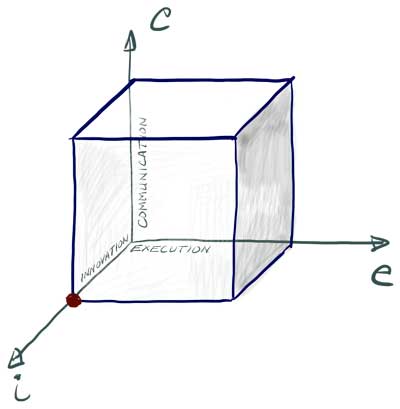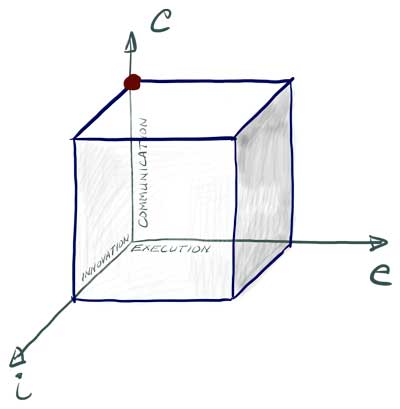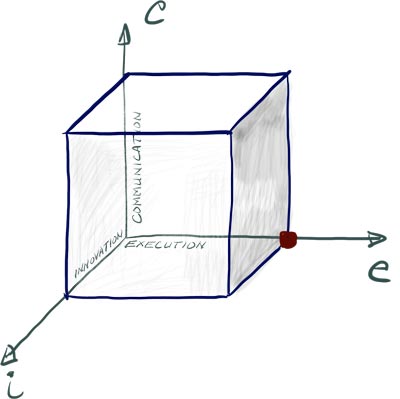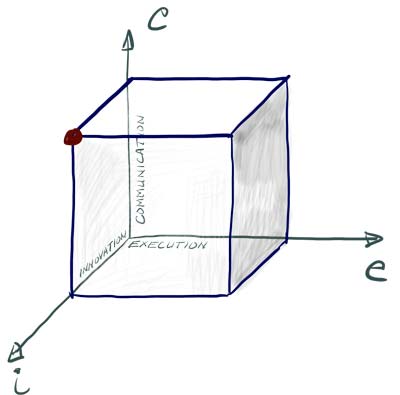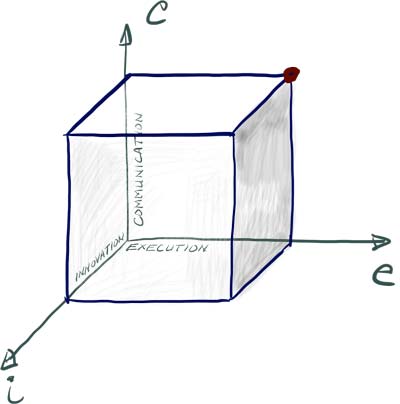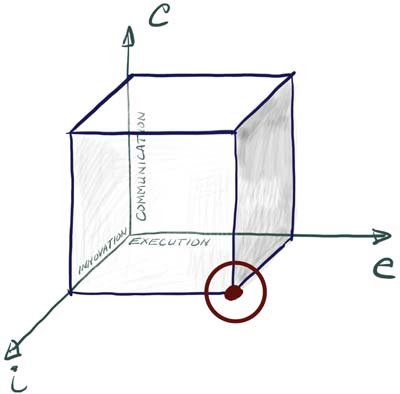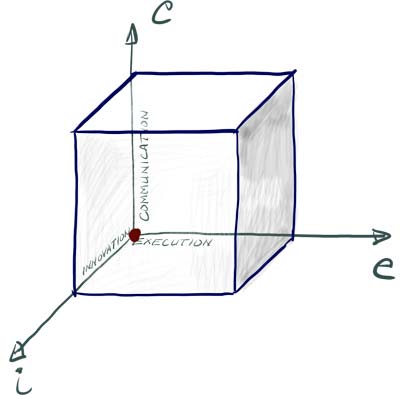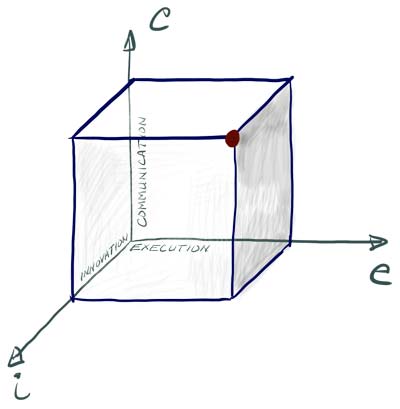The Eight Corners

Chances are, you are not equally good at innovating, communicating and executing. Pretty much no one is. Most people are pretty strong in two and weaker in the third. This stems from the fact that coming up with ideas, communicating and getting things done are very different activities and make use of different parts of the brain. None of our brains are perfectly balanced, and people tend to gravitate to what they are good at, get better at it, and avoid what they are not.
This makes it useful to think of the “Eight Corners” of the ICE Cube as personality types. Imagine we could score every person you work with in terms of how good they are at innovating, communicating and executing. But the only score we could give is 0 or 1. 0 equals “not very good at it, and doesn’t like to do it,” and 1 is “very good at it, loves to do it.” So someone who is great at Innovating and great at Communicating but terrible at getting things done would get shown on the front left corner of the ICE Cube where I = 1, C = 1 and E = 0.
Each corner of the cube represents a personality type. And just like learning someone’s Myers Briggs (ENTJ, ISFP, etc...) or DISC (D, I, S or C) types can be useful, so can thinking about which corner of the cube someone is most comfortable in. The eight types are as follows:
“The Inventor”
I = 1, C = 0, E = 0
Someone who is great at coming up with ideas but doesn’t like to interact with people and never gets anything done. They have all kinds of ideas for the next great thing but nothing ever comes of any of it.
“The Preacher”
I = 0, C = 1, E = 0
Someone who is a gifted communicator but doesn’t bring any of their own ideas to the table or get any work done. They also can be thought of as spin doctors, or PR people. They love to craft and deliver the message, but not much else.
“The Soldier”
I = 0, C = 0, E = 1
Someone who loves to follow orders and get stuff done, but doesn’t come up with original thoughts or communicate effectively. They are great laborers but get stopped by the simplest obstacles. And don’t even bother to tell you they’re stuck.
“The Consultant”
I = 1, C = 1, E = 0
Someone who loves ideas and loves to share them. But doesn’t ever seem to implement any real change. They like to think that doing the real work is someone else’s job.
“The Manager”
I = 0, C = 1, E = 1
Someone who loves to organize people and make things happen. The bigger the change, the bigger the project, the better. It is not a concern to them whether or not the underlying idea is a good one or not. They are frustrated by questions like, “Are you sure doing this will actually make things better?” and they are fond of the phrase, “People don’t like change.”
“The Expert”
I = 1, C = 0, E = 1
Someone who is happy to master their job and do it over and over without interacting with anyone. They usually know more about the process, how it works and what would make it better than anyone else. But they don’t like sharing ideas and can find communicating with others frustrating. They like to be in control of their own universe so they can perfect things and very much don’t like less knowledgeable people trying to tell them how to do their jobs.
“The Zombie”
I = 0, C = 0, E = 0
Someone who doesn’t do anything. They don’t like ideas or learning, they don’t see the need to communicate, and they never get anything done. This kind of person doesn’t actually exist in the real world. Everyone seems to gravitate to at least one of the leadership dimensions.
“The Leader”
I = 1, C = 1, E = 1
Someone who is perfectly balanced in their interests and skills. They love ideas, learning and figuring things out. They love to share with others; cooperate and coordinate; and get things done. This perfectly balanced person doesn’t exist in the real world either. Just as everyone seems to gravitate towards one or two of the dimensions, everyone seems to avoid the one they are weakest in as well.
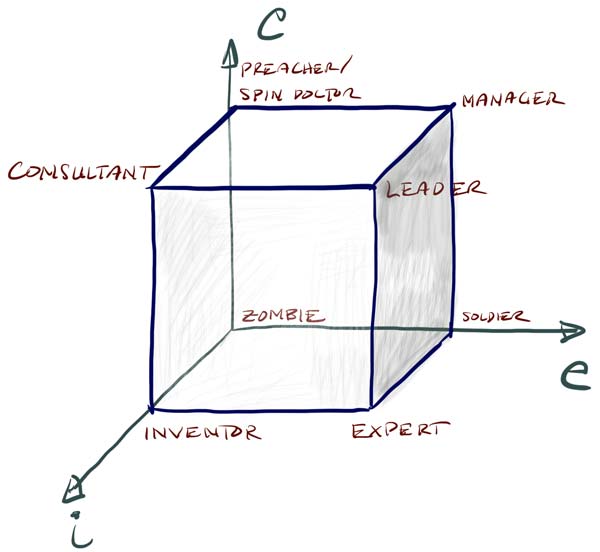
I’ve presented each of these types as fairly negative caricatures, but this is how they are perceived if they let their weak dimensions become liabilities. I find it amazing how familiar everyone is with each of these stereotypes, and how frustrated people get when working with someone whose type is their opposite. But just like the diversity experts have been telling us for years, diverse teams, if they can get along, vastly outperform non-diverse teams. Each personality type is complemented best by their exact opposite. You’re type is Soldier? The type that would make your best possible teammate, if you can stand being around them, is the Consultant. Why? You need ideas to execute and someone to help you communicate with stakeholders. You’re type is Preacher? Then the type you should be looking to work with is the Expert. They could use your help sharing their great ideas and the benefits they are achieving by getting them done with other folks who could use them as well. The higher you go in an organization the more important it will become for you to find other players who compliment your weakest dimension with their strongest.
One of the best teams I have ever seen in action was the CEO of GE Capital, Gary Wendt, and it’s President, Dennis Nayden. Together they grew GE Capital from virtually non-existent to a powerhouse that generated half of General Electric’s net income. Gary was practically a mad genius, somewhere between Inventor and Consultant in personality type. He was famous for odd, almost disrespectful behaviors during presentations. There were stories of him eating the muffin tops off of every muffin and putting what was left back in the basket as if someone would finish them; chewing his way through an entire Styrofoam cup when bored with a presenter; or digging wax out of his ear with a pen and then pointing the pen at someone to punctuate a point he was making. Dennis was the exact opposite. Somewhere between Soldier and Manager. If Wendt was Albert Einstein, Nayden was George S. Patton. He was all business, all make it happen, all the time. Nobody knew how they got along. But whatever Gary dreamed up as a way to print more money, no matter how complicated and undoable, Dennis could rally an army to make it happen. Keep in mind, these guys were among the most successful business leaders in the world and their weakest dimension would be anyone else’s biggest strength. But they were both keenly aware that as a team they were 100 times what they each were as separate individuals. And Jack Welch was smart enough to have them working together to build GE Capital, making it the biggest of many big cylinders in GE’s growth engine.
So learn your type. And learn to identify what other people’s types are. And learn to tolerate and work well with your opposite. They will add more value to what you do than anyone else.
